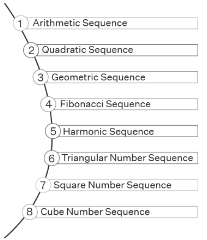In mathematics, a sequence is a list of components, usually integers, where the components’ order is important. Here, everything fits into a predetermined pattern. In real life, we encounter sequences frequently. Sequences include things like house numbers in a row, income increases over time (by a certain dollar amount or percentage), book pages, etc.
Overview on figure problem
A question may have five figures in a sequence, each with the lettersA, B, C, D, and E. These kinds of reasoning questions are based on a series of pictures. Problem figures are those that show a change over time step by step. Following the problem figures are five answer figures with the numbers 1, 2, 3, 4, and 5.
Figures in a sequence
List of numbers (or other components) that follows a specific pattern is called a sequence. Olivia, for instance, has been given a position with a beginning monthly pay of $1,000 and a $500 yearly raise. Are you able to determine her monthly pay for the first three years? $1000, $1500, and $2000 will be the amounts. Observe how Olivia’s pay over a number of years creates a sequence since the numbers always increase by $500, following a pattern.
The sequence’s order
A sequence can be arranged in either ascending or descending order.
In Ascending Order
The sequence is in ascending order if its components are arranged in ascending order.

The order in which the phrases are listed above is ascending since they are “growing” by2.
In Decreasing Order
The sequence is in descending order if its components are arranged in ascending order.

As the words are “decreasing” by 4, the preceding order is descending.
Sequences, Finite and Infinite
Finite and infinite sequences are the two different types of sequences. The number of phrases in a finite sequence may be counted. Any sequence that is not finite is said to be endless.
Finite Sequence
A finite sequence is one that has a finite number of terms. A finite sequence, for instance, is the number of bounces a ball needs to make before coming to rest.
The infinite Sequence
An endless sequence is one that has an unlimited number of terms. For instance, the natural number series1, 2, 3, 4, and so on creates an infinite sequence.
Mathematical Sequence Types
A few unique sequences are the triangular number series, square number sequence, cube number sequence, Fibonacci sequence, geometric sequence, and arithmetic sequence. In addition to these, sequences can also follow different patterns. For instance, the sequence 2, 9, 28, 65,…, has integers that may be expressed as 13 + 1, 23 + 1, 33 + 1, 43 + 1,…, yet it does not fit into any of the following categories.
Quadratic Order
As we’ve already seen, an arithmetic sequence is defined as having initial differences (also known as differences between every two succeeding terms) that are equal (which is also known as a linear sequence). However, the series is referred to be a quadratic sequence if the second differences are the same but the first differences are not.
Figures are called problem figures which depict a change step by step.
The second solution figure should finish the series as it is the only answer figure that bends similarly to the alternate problem figure in this series of problem figures, that is, towards the left upper corner.
Conclusion
Problem figures are those that show a change over time step by step. However, the series is referred to as a quadratic sequence if the second differences are the same but the first differences are not. A finite sequence, for instance, is the number of bounces a ball needs to make before coming to rest. Here, everything fits into a predetermined pattern. In real life, we encounter sequences frequently.
 Profile
Profile Settings
Settings Refer your friends
Refer your friends Sign out
Sign out







